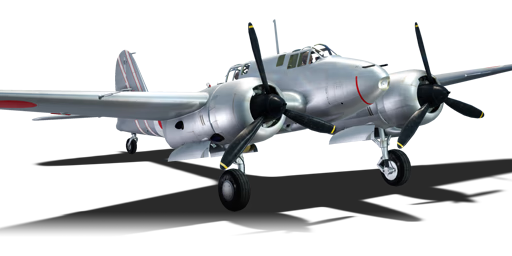



The Ki-45 Kai-Kō, otherwise designated as Type 2 Two-Seat Fighter, Improved Model A (Kō/甲) (二式複座戦闘機 甲型), was the first production variant of the Ki-45 aircraft. It was developed alongside the Ki-43 and Ki-44 to modernise the Imperial Japanese Army (IJA) Air Service with a general-purpose, twin-seat aircraft.
Initial development followed the trend of multi-purpose twin-seat aircraft development in the West, which initially led Kawasaki to build the twin-engine, single-seat Ki-38 with Ha-9 engines. This was later rejected and used as the basis for the Ki-45 when the Army requested a twin-seat aircraft. Initial prototypes of the Ki-45 were equipped with Ha-25 engines but they were underpowered. Its engine upgrade was dubbed the Ki-45 Kai, re-equipping it with the more powerful Ha-102 engines.
Introduced in Update 1.31, the Ki-45 Kai-Kō is armed with two 12.7 mm machine guns in the nose and a belly-mounted 20 mm cannon, giving it the most forward-mounted ammunition in the Ki-45 series. As a twin-engine heavy fighter, it excels in Boom-and-Zoom tactics. While it boasts heavy armament and increased engine power, its climb rate and roll rate are relatively mediocre. For optimal performance, it's best to initiate combat with shallow climbs and execute straight, powerful dives when engaging targets.
flaps
flaps
flaps
brake
| Belt | Belt filling | Armor penetration (mm) at a distance: | |||||
|---|---|---|---|---|---|---|---|
| 10 m | 100 m | 500 m | 1000 m | 1500 m | 2000 m | ||
| FI/HEFI-T/HEF-I/AP-T | 36 | 34 | 25 | 17 | 12 | 8 | |
| HEFI-T/HEF-I/AP-T | 36 | 34 | 25 | 17 | 12 | 8 | |
| AP-T/AP-T/FI/HEF-I | 36 | 34 | 25 | 17 | 12 | 8 | |
| AP-T/HEFI-T | 36 | 34 | 25 | 17 | 12 | 8 | |
| FI/FI/HEF-I/HEF-I | 5 | 4 | 3 | 3 | 3 | 3 | |
| Belt | Belt filling | Armor penetration (mm) at a distance: | |||||
|---|---|---|---|---|---|---|---|
| 10 m | 100 m | 500 m | 1000 m | 1500 m | 2000 m | ||
| AP-T/AP/HEF-I | 21 | 19 | 13 | 7 | 4 | 3 | |
| AP-T/HEF-I/AP/HEF-I | 21 | 19 | 13 | 7 | 4 | 3 | |
| AP-T/HEF-I/HEF-I/HEF-I | 21 | 19 | 13 | 7 | 4 | 3 | |
| AP-T/AP/AP-T | 21 | 19 | 13 | 7 | 4 | 3 | |
| AP/HEF-I/HEF-I/HEF-I | 21 | 19 | 13 | 7 | 4 | 3 | |
| Belt | Belt filling | Armor penetration (mm) at a distance: | |||||
|---|---|---|---|---|---|---|---|
| 10 m | 100 m | 500 m | 1000 m | 1500 m | 2000 m | ||
| AP-T/Ball/Ball/AP-I/AI | 9 | 8 | 6 | 3 | 0 | 0 | |
| AP/AP/AP/AP-T | 13 | 12 | 7 | 3 | 2 | 0 | |
| AP-I/AP-T/AP-I/AP-T | 9 | 8 | 6 | 3 | 0 | 0 | |












Flight performance | |
|---|---|
Survivability |
|---|
Weaponry | |
|---|---|